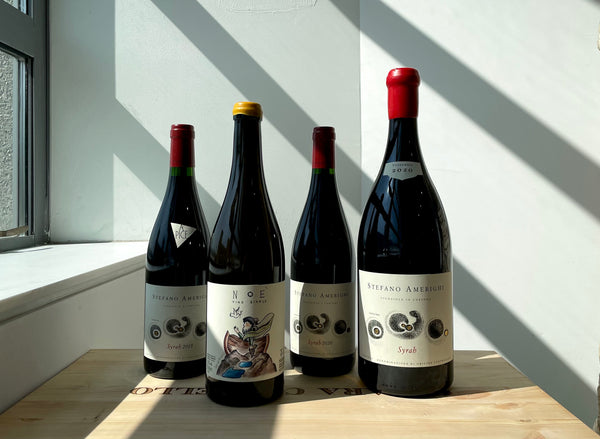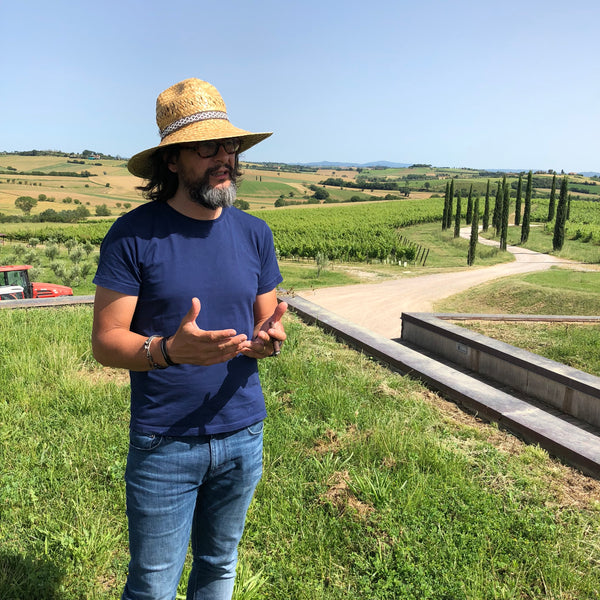Your cart is empty!
Stefano Amerighi's Transformative Bio Syrah
05/11/23

Stefano Amerighi's focus is at his Tuscan estate in Cortona, but his curiosity and talent seemingly have no limit.
He’s retraced Pecorino’s genetic origin to the Marche. Resuscitated an almost extinct varietal in Sicily with a who's-who of Italian natural wine peers. And he's making an inspired *secret* Sangiovese (look out Leon Circle members!!).
But what has us writing today is the special work he's doing in his homeland of Cortona, making some of the best Syrah from anywhere.

You can see Stefano’s deep appreciation for the Northern Rhône in his wines. His style is full of spice and brine that recall some of his favorite growers (think Thierry Allemand), but picking for phenolic maturity shows the dark fruit that comes with the Tuscan sunshine.
With an inspiring spirit and desire to bring past to present (which to be honest, reminds us of Tegan Passalacqua’s work in California), Stefano is retracing Cortona’s ancient history and showing the world why this place has been a perfect home to Syrah for almost 400 years.

ABOUT CORTONA:
It's a rare Italian DOC that's known for Syrah, located just northeast of Montepulciano on Tuscany's border with Umbria.
The climate and terroir are extremely similar to the Rhône [and it's probably what many people would picture: Under the Tuscan Sun was filmed here].
The climate and terroir are extremely similar to the Rhône [and it's probably what many people would picture: Under the Tuscan Sun was filmed here].
IF YOU LIKE DETAILS AS MUCH AS WE DO:
Stefano is maniacal about low-impact farming; the estate is Demeter-certified and follows the principles of Masanobu Fukuoka. There are fruit trees, various grains, olives, Chianina cattle, pigs, geese, and hens surrounding the vineyards.
His work really started after a geological investigation in 2001, where he idenfitied the perfect 8h of land: southeast exposure, a mix of silty clay sedimentary soil, and a base of thriving microorganisms. Stefano's cru is in Poggiobello di Farneta, in the Chiuso di Cortona, the last hills descending down from the town. Unlike the rest of the area, it was not an ancient seabed, and is rich with dinosaur fossils.
His Pecorino project ‘Noe' retraced the grape to its genetic origins in the Monti Sibillini of Le Marche, at 900-1000m above sea level, where he discovered 100+ year old, ungrafted vines. More than just crisp white wine, he's making a macerated Pecorino that is deeply reflective of this place.
He's also one of six winemakers collaborating at Halarà in Marsala, a one hectare vineyard planted to Parpato and Catarratto.
Stefano is also the president of the consorzio of Cortona.
His work really started after a geological investigation in 2001, where he idenfitied the perfect 8h of land: southeast exposure, a mix of silty clay sedimentary soil, and a base of thriving microorganisms. Stefano's cru is in Poggiobello di Farneta, in the Chiuso di Cortona, the last hills descending down from the town. Unlike the rest of the area, it was not an ancient seabed, and is rich with dinosaur fossils.
His Pecorino project ‘Noe' retraced the grape to its genetic origins in the Monti Sibillini of Le Marche, at 900-1000m above sea level, where he discovered 100+ year old, ungrafted vines. More than just crisp white wine, he's making a macerated Pecorino that is deeply reflective of this place.
He's also one of six winemakers collaborating at Halarà in Marsala, a one hectare vineyard planted to Parpato and Catarratto.
Stefano is also the president of the consorzio of Cortona.
